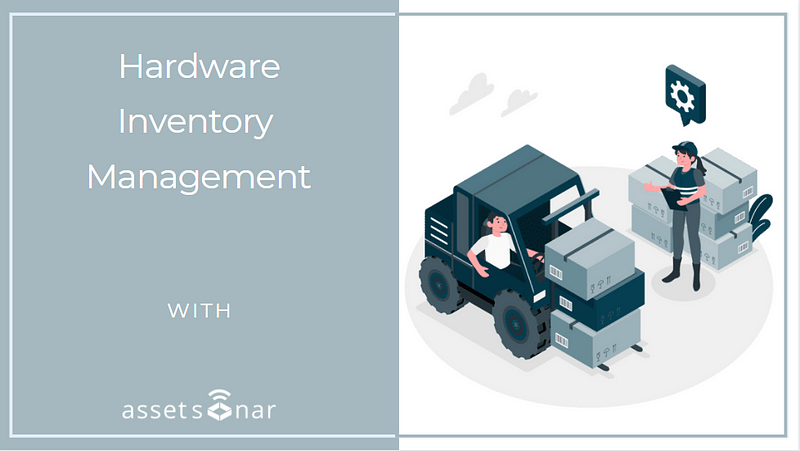What is IT hardware inventory management?
IT hardware inventory management is a strategy to monitor the utilization of hardware devices like laptops and printers from the time of procurement to disposal. Despite being one of the fundamental institutions of an organization, few companies have the needed routines in place.
Most companies make little effort to supervise their critical assets and rely on outdated data. IT assets are especially hard to monitor as they are constantly changing because of frequent software upgrades and new device installations.
To account for such events and streamline management, it’s crucial to rely on real-time data to gauge the current state of your assets. Automated tools help companies do this by maintaining an updated data log at all times.
But with so many options out there, procurement decisions should be made consciously. A robust and dependable asset management system would feature:
- An IT asset repository
- Hardware inventory and usage information
- Integration with adjacent IT business platforms
- Support for importing and exporting data
Keeping regular tabs on the IT hardware inventory information lets you gain useful insights into business operations. Accurate data enables companies to easily comprehend what types of systems and equipment exist and where are the relevant components located.
Firms can also note down the exact date when new stock is added to the inventory. Doing so helps document the asset lifecycle and allows you to regulate maintenance costs whenever necessary.
Why should you implement an IT hardware inventory management program?
A successful asset management program demands support and automation. Organizations that rely on a complete management routine tailored for their own company, have higher chances of boosting overall performance. With thorough insights into hardware utilization, expect the following benefits:
- Improved visibility: By following an end-to-end user control system, you can easily keep tabs on all deployed assets. You can cross-check whether a specific tool is being used for its assigned job.
- Control on costs: Investing in IT devices is costly which is why it is critical to monitor utilization to minimize wastage and regulate their finances.
- Better service management: Instant updates keep all team members informed about the current status of IT assets. A central platform where employees can post queries and checkout items along with location pins provides a fundamental base for efficient transactions.
- Lower security and compliance risks: With the right procedures in place, companies can gain regulatory and contractual compliance. Following standardized practices allows you to run business operations with greater accuracy and keeps you safe from hefty non-compliance fines.
Which business sectors use hardware assets and how?
Various types of industries in the market require specific tools to carry out business operations. Companies invest in asset bundles according to the tastes and preferences of end consumers. To ensure user satisfaction, it is important to outline a robust tracking strategy.
Such a practice enables organizations to adopt a proactive approach to discharging daily functions to avoid unnecessary delays. Some of the common institutions and their hardware choices include:
1. Schools

It is a constant challenge for educational institutes to buy hardware on a tight budget. For this reason, most schools have to be very careful about each and every purchase. This is why durability, reliability, and compatibility, all become key when buying hardware.
Modern teaching is also incorporating more and more technology into the learning process. This is why hardware with touch screens, inking, real-time whiteboarding, and video conferencing support is becoming more popular in schools. That’s not all; innovative technology like digital pens and 3D printers is also on the rise.
Hardware that has been procured so carefully and responsibly needs to be looked after. School-owned laptops and tablets are frequently used which is why they should be carefully monitored- both during and after usage.
2. Audio-visual companies
With advancements in the audio-visual sector, AV companies can no longer survive without offering high image quality and crisp sound effects. This is why they invest a significant part of their budgets into getting the right type of screens, including LCD monitors and overhead projectors.
More and more companies are engineering new devices rapidly which is why there is a wide range of lighting and display options for every price range. In addition to this, AV companies also like to house powerful speakers and wireless microphones.
For these reasons, dealing with an extensive range of IT equipment can get quite complicated. To ensure seamless workflows, AV firms should devise a tracking mechanism to oversee all daily tasks.
3. Supermarkets
Large wholesale and grocery stores operate in a very fast-paced environment. To cater to multiple customers at a point-of-sale terminal, supermarkets require a dependable backup and support system. This is usually the server hardware; a computer faster than others and forms the central location for all database information and management functions.
Moreover, supermarkets stock printing scales with a variety of printing formats. Scanner scales are mostly used for reading printed barcodes used as ID tags for grocery items. Generally, employees have a handheld barcode scanner as well to quickly locate products and their particular details within seconds.
With so many hardware components being used in crucial areas, there’s a need for a rock-solid management system to streamline hardware-related workflows.
Principle features of an IT hardware inventory management program
High demand for your product is only sustainable if you derive the desired rate of return. Here are a few features of IT asset management that organizations should monitor to optimize utilization and in turn, maximize their rate of returns:
1. Inventory levels

Maintaining a balance between stock quantities poses a challenge for many organizations. For IT hardware assets, companies have to ensure that every device is in working condition at all times. Even if some of the computers are checked out for maintenance, firms should have sufficient buffer stock to avoid any delays in the workflow.
The best solution is to opt for a cloud-based system that automates the procurement process. By assigning a unique barcode to all tools, you can enter all equipment into the database. After this, you can set minimum threshold levels for all items in stock. Once this limit is reached, purchase orders are automatically created.
Management software also lets you create a list of vendors. Such practices allow you to trace back procurement chains and refer to the same vendor in case of a reorder. You can also filter out manufacturers in the case of damaged goods or poor after-sales services.
2. Stages of the asset lifecycle
Capital assets have a tendency to depreciate over time. This pattern isn’t uniform for all resources and therefore, needs to be monitored very closely for different types of equipment. If you plan out what assets you need and for what purpose, you will be better able to assess the practical sufficiency of a particular investment.
After laying down the basic procurement list, organizations acquire the necessary IT equipment. From this moment onwards, it becomes essential to record usage history to account for depreciation. Let’s take the example of a printer.
Whenever companies decide to buy a printer, the first thing they consider is the duty cycle. This metric is provided by the manufacturer and refers to the absolute number of pages that can be printed in a month.
Say, for an inkjet printer, the duty cycle is 8000 pages per month. If this limit is reached within a month, the company will check the device for maintenance or upgrade the cartridge. Once the printer finally runs the course of its useful life, it is disposed of.
In order to do all this in a timely manner, it is crucial to track different stages of IT assets. Failure to do so may result in unwanted breakdowns, errors in business functions, and overhead costs.
3. Hardware user access
Business data security is a top priority and organizations should work towards implementing strict protocols to ensure user compliance. Having multiple hardware devices with no inspection of access increases the threat of malware and data breaches. This could ultimately result in data loss.
To avoid such mishaps, organizations adopt management software to limit user control. You can define roles for all team members and limit visibility on the basis of location, groups, or departments. If a company has sensitive data that can only be shared with a specific set of personnel, it can specify which members can log in to gain full access.
For quick checkout of hardware assets, firms can enable user ID scans. This lets employees show proof of authentication when taking out items for use. More security options let you set passwords and ask for administration approval for certain actions. Actively tracking users at all times enables organizations to improve transparency and credibility.
4. Maintenance schedules

With a large IT resource base, the ultimate goal is to maximize efficient allocation. One way to do this is by ensuring that all assets are working at full capacity without untimely breakdowns. But how can companies do this without a maintenance plan in place?
Asset management software allows companies to prepare extensive service and repair sessions. By checking in equipment as soon as it is procured, firms can generate service tickets to flag urgent issues. Moreover, you can also schedule recurring sessions for periodic service and regular inspections.
To notify team members about the unavailability of certain laptops and projectors, you can also send out alerts. Tracking service history allows you to keep a tab on costs and minimize expenditures to increase productivity.
Following a rigid maintenance schedule allows organizations to:
- Improve conservation of assets which leads to higher life expectancy.
- Establish preventive maintenance that eliminates the need for large-scale repairs in emergency events.
- Enforce better safety and working conditions for employees.
5. License and warranties
IT manufacturers have specific guidelines that define how certain assets should be used. These are usually labeled as a license and issued at the time of procurement. Having a valid license for IT hardware makes it eligible for upgrades while product warranties lay down a time period during which the vendor takes responsibility for repairs in case of damage.
Both licenses and warranties are crucial for the optimal utilization of hardware assets. Therefore, using management software makes it easier to enter and store such information on a single platform. Carrying out internal audits also lets you survey and inspect which items need maintenance and which service event falls under the warranty period.
Consequently, tracking licenses and warranties enable companies to boost efficiency by reducing overhead costs.
Make the most of your IT hardware inventory management strategy
Technology is only truly helpful if people know how to make the most of it. Deploying management software alone will not solve your management woes if your employees aren’t well-versed in software usage. So be sure to adequately train your employees when you decide to integrate any new technology into your workflows.
Another thing to note is that managing IT assets requires a proactive approach. Most companies only deal with roadblocks as they come without anticipating any of them beforehand. Instead of doing this, establish a dynamic workflow that makes room for innovation.
- First, clearly define areas of management such as hardware, networks and communications, and mobile devices.
- Next, prioritize assets as not all equipment needs extensive monitoring. This should be reflected in the business strategy.
- Lastly, lay down goals and track the key metrics required to consistently improve outcomes. For instance, if you want to refine purchase decisions, you need to track depreciation rates and maintenance costs.
Finally, companies should remember that hardware management is not a one-and-done procedure – it’s an ongoing process. Be sure to diligently set up business practices and be consistent throughout.
About AssetSonar
AssetSonar is the leading hardware asset management software for IT-intensive organizations and businesses all over the globe.
Sign up today for a free 15-day trial.
For more assistance, drop us an email at support@ezo.io. You can also visit our blog for detailed support posts.







